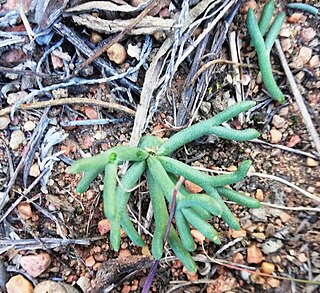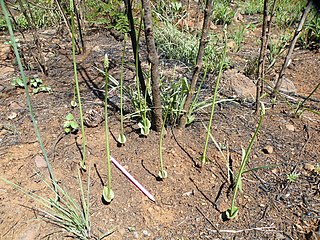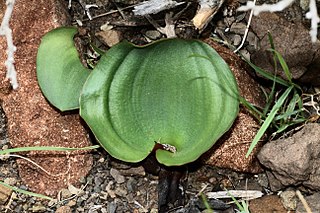
Haworthia is a large genus of small succulent plants endemic to Southern Africa (Mozambique, Namibia, Lesotho, Eswatini and South Africa).

Eriospermum is a genus of tuberous flowering plants. It contains about 80-100 species, native to sub-Saharan Africa.

Eurybia is a genus of plants in the family Asteraceae that were previously included in the genus Aster. Most species are native to North America, although one is also present in northern Eurasia. There are 23 species in the genus, including 1 natural hybrid. The name was first applied by Alexandre de Cassini in 1820. The name is derived from Ancient Greek εὐρύς (eurús), meaning "wide", and βαιός (baiós), meaning "few", perhaps in reference to the small number of relatively wide ray florets.

Mangifera zeylanica or "Sri Lanka wild mango" is a wild species of mango tree endemic to Sri Lanka. This stately tree is the tallest member of the mango genus, Mangifera, and one of the two tallest trees in the family Anacardiaceae. The mango fruits are edible and have an excellent taste. It is called "aetamba" (ඇටඹ) or "wal amba" in Sinhala and “kaddu-ma” in Tamil. The well-known British botanist and explorer Joseph Dalton Hooker first described the tree in 1876.

Sorocephalus is a genus containing 11 species of flowering plants, commonly known as powderpuffs, in the family Proteaceae. The name means “heaped head”. The genus is endemic to the Cape Floristic Region of South Africa, more particularly the winter rainfall zone of the southwestern Cape. The species are all small shrubs characterised by flower-heads containing clusters of four or more flowers. Most species are threatened.
Lactuca dissecta, the split-leaf lettuce, is an Asian species of plant in the tribe Cichorieae within the family Asteraceae. It is native to Central Asia, western China, the Himalayas, and southwest Asia as far west as Turkey.
Iris sikkimensis is a plant species in the genus Iris, it is also in the subgenus Iris and in the section Pseudoregelia. It is a rhizomatous perennial, from Sikkim. It has pale green or light green thin leaves, slender stem, 2 or 3 lilac or purple flowers, with a white beard with orange tips. It is thought to be a hybrid of Iris hookeriana and Iris kumaonensis.

Euphorbia tuberosa, commonly known as '"milkball/melkbol"' or '"wilderamenas"', is a variable geophytic plant of the family Euphorbiaceae, indigenous to the western parts of South Africa.

Eriospermum bowieanum is a species of geophytic plant of the genus Eriospermum, endemic to the Robertson Karoo region of the Western Cape Province, South Africa.

Eriospermum cooperi is a species of flowering plant of the Asparagaceae family. It is a summer rainfall species found in rocky grassland and open scrub from the Eastern Cape, South Africa to Zimbabwe. It has a solitary erect leaf, white to pale green flowers and grows to 60 cm. The outer tepals are sometimes reddish brown.
Eriospermum breviscapum is a species of geophytic plant of the genus Eriospermum, indigenous to South Africa.
Eriospermum dregei is a species of geophytic plant of the genus Eriospermum.

Eriospermum capense is a species of geophytic plant of the genus Eriospermum, indigenous to the Western Cape Province, South Africa.
Eriospermum bayeri is a species of geophytic plant of the genus Eriospermum, indigenous to the Western Cape Province, South Africa.
Eriospermum graminifolium is a species of geophytic plant of the genus Eriospermum, indigenous to South Africa.
Eriospermum zeyheri is a species of geophytic plant of the genus Eriospermum, indigenous to South Africa.
Eriospermum pubescens is a species of geophytic plant of the genus Eriospermum, indigenous to the southern Cape, South Africa.
Eriospermum exile is a species of geophytic plant of the genus Eriospermum, indigenous to South Africa.

Drimia capensis ("Maerman") is a species of geophytic flowering plant in the family Asparagaceae, subfamily Scilloideae, indigenous to the south-western parts of South Africa.

Xylonagra arborea is a flowering plant endemic to the western side of the Baja California Peninsula. It is a bushy shrub distinguished by showy, scarlet flowers that are attractive to hummingbirds. It is the sole species in the genus Xylonagra, which belongs to the family Onagraceae.











